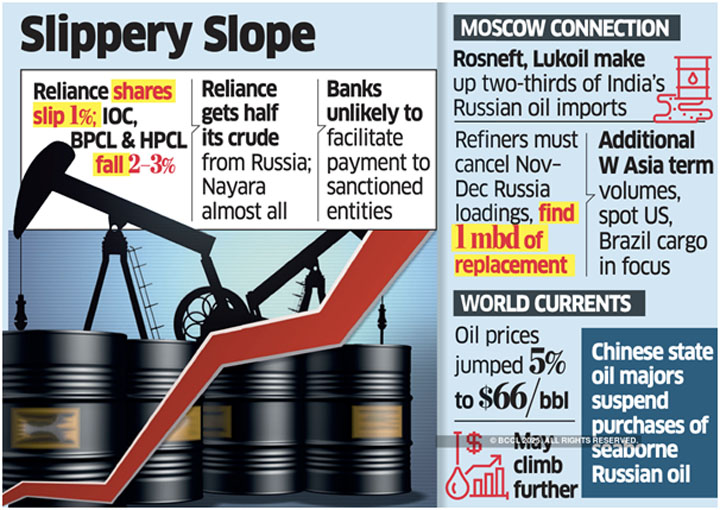The new sanctions on Russia’s oil majors have reopened questions about where global power really lies. Washington’s move to target Rosneft and Lukoil, backed by London and Brussels, is not another routine tightening of screws. President Donald Trump unleashed sanctions on Russia’s two energy titans: Rosneft and Lukoil, along with most of their subsidiaries. The move marks the first decisive anti-Moscow step of his second term. Brussels banned Russian LNG imports and extended restrictions to banks, crypto exchanges, and even Russia’s “shadow fleet” of tankers. Britain’s measures mirrored Washington’s, signalling a unified transatlantic playbook. It is a signal that the financial system itself has become an extension of the strategy of coercion. What’s unfolding isn’t merely another Western show of pressure against Moscow; it’s a structural reset in global energy and financial alignments.
For India, which has relied on discounted Russian crude to stabilise energy costs, this is not just a story about Moscow. It is about how long we can continue operating inside a ruleset that others keep rewriting. It could soon mean a forced choice between barrels and balance, autonomy and alignment. There is a subtle difference in the interpretation of this term – F(oiled)
A Deeper Economic Strike
Rosneft and Lukoil together account for the bulk of Russia’s oil exports and a large part of its budget revenue. Sanctioning them means going after the engine that funds the Russian state. Earlier rounds of sanctions left escape routes; this one closes them. Any company that trades, ships, or settles payments with these firms now risks secondary penalties.
That is already changing behaviour. Refiners across Asia are rechecking contracts. Shipping insurance is getting harder to secure. Payments routed through smaller banks or alternative currencies face delays. What looked like a stable arrangement between India and Russia is suddenly subject to friction at every step.
Inputs suggest that the impact is immediate. Indian refiners, including those in the private sector, have reportedly been contemplating trimming Russian crude purchases. Chinese buyers, already under Western scrutiny, are expected to follow suit to avoid secondary sanctions. The ripples will reach every port where Russian crude is blended, relabelled, or resold.
The effect on Moscow? Severe. Energy revenues fund nearly one-third of the Russian federal budget. Even a 10% contraction in exports could slash billions from its war chest. More importantly, it punctures the illusion of an impregnable “energy fortress.”

India’s Policy Squeeze: Between Sanction Lines and Strategic Needs
India’s logic since 2022 has been straightforward: buy where it’s cheapest, and keep inflation in check. It was termed as national interest and strategic autonomy. The argument worked because energy security is not a moral issue; it’s an economic one. But the new rules make that calculation tougher. Public sector refiners tied to Western credit and insurance networks will find it nearly impossible to ignore U.S. compliance risks. Even private players will have to weigh exposure to the dollar system against the savings from Russian crude.
This is not a question of choosing sides. It is about keeping the system running. Reduce Russian imports too sharply, and fuel costs rise. Stay the course, and you invite sanctions risk. There are no clean options left. It’s strategically a Catch-22 situation.

Fragmenting the Energy Map
What we are witnessing is not a passing phase but the slow breakup of a global market. Oil once moved freely through a single pricing and payment network. Now, two parallel systems are taking shape. The Western bloc still controls finance, logistics, and insurance. Russia, Iran, and others are building smaller, closed circuits around China. Most others, including India, must navigate between them without getting trapped.
For Putin, this is a knife to the jugular. Russia’s economy has already shrunk by over 15% since 2022. With limited access to Western tech, its oil production is stagnating. Sanctions on Rosneft and Lukoil choke not just exports but also future investments in exploration and refining capacity. Even China, Russia’s supposed saviour, is cautious, unwilling to risk its own access to Western markets.
For Washington, this reordering is strategic. Restricting Russian supply keeps prices firm and gives room for U.S. exports. Europe, after cutting dependence on Russian fuel, is using regulation to ensure no one else undercuts it. The idea is simple: shape the market by shaping the rules.
The old assumption that oil is too global to be politicised is dead. What we’re witnessing is the birth of a sanctioned globalisation, where energy flows not by efficiency but by allegiance. The new energy blocs are already forming:
- The Transatlantic Bloc (U.S.–EU–UK): controlling finance, insurance, and shipping networks.
- The Eurasian Bloc (Russia–Iran–China): bound by necessity, not trust.
- The Non-Aligned Buffer (India, Gulf states, parts of ASEAN): trying to navigate the fault lines.
India’s Way Forward
India has handled external pressure before, usually by keeping a low profile and acting pragmatically. The same playbook still applies, but with tighter margins.
- Diversify supply. More oil from the Gulf, the U.S., and Africa will spread risk, even if costs rise in the short term.
- Secure payment channels. The Rupee–Ruble route helped, but it remains narrow. Wider settlement systems through BRICS or regional arrangements will be needed.
- Shield public firms. Separate intermediaries for sensitive trades can protect major PSUs from legal exposure.
- Stay engaged on both sides. The U.S. and Europe must hear India’s case on economic necessity, while Moscow remains an all-weather, important defence and energy partner.
None of this will be easy, but it is better than drifting into a sanctions dispute we can neither control nor win.
Reading the Message
The deeper lesson lies beyond oil. Sanctions are becoming the preferred weapon of modern power, cheaper than war, quieter than diplomacy, and far more intrusive. Connectivity, once seen as a guarantee of stability, has become leverage. The same trade and financial systems that lifted growth are now being used to enforce compliance.
For a country like India, autonomy will depend less on rhetoric and more on economic capacity. The ability to make and finance our own choices will define strategic independence in the decade ahead.
In Closing
What began as pressure on Russia is now a test for everyone who sits outside Western alignments. The price of oil, the cost of shipping, and even the value of the rupee will feel the effect of decisions taken in Washington and Brussels. That is the new reality.
India has managed shifting currents before. Doing it again will need clear thinking and calm execution, not slogans about neutrality, but a hard look at what keeps the engine of the economy turning. The world is moving into an era where markets, banks, and compliance desks do what armies once did. Staying ahead will mean understanding that power now flows through ledgers as much as through the launch of missiles.
ABOUT THE AUTHOR
 Lieutenant General A B Shivane, is the former Strike Corps Commander and Director General of Mechanised Forces. As a scholar warrior, he has authored over 200 publications on national security and matters defence, besides four books and is an internationally renowned keynote speaker. The General was a Consultant to the Ministry of Defence (Ordnance Factory Board) post-superannuation. He was the Distinguished Fellow and held COAS Chair of Excellence at the Centre for Land Warfare Studies 2021 2022. He is also the Senior Advisor Board Member to several organisations and Think Tanks.
Lieutenant General A B Shivane, is the former Strike Corps Commander and Director General of Mechanised Forces. As a scholar warrior, he has authored over 200 publications on national security and matters defence, besides four books and is an internationally renowned keynote speaker. The General was a Consultant to the Ministry of Defence (Ordnance Factory Board) post-superannuation. He was the Distinguished Fellow and held COAS Chair of Excellence at the Centre for Land Warfare Studies 2021 2022. He is also the Senior Advisor Board Member to several organisations and Think Tanks.








